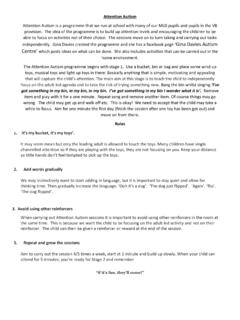Transcription of Attention Autism Approaches Bucket Time Activities
1 MAIDSTONE SPECIALIST TEACHING & LEARNING. SERVICE. Attention Autism Approaches Bucket time type Activities Gina Davies (Specialist Speech and Language Therapist) developed Attention Autism as a creative and highly motivating intervention to support the development of Attention and early communication skills of those children with Autism . This approach builds upon the neurotypical developmental stages within the PSED and C&L. areas of learning in the EYFS, as well as harnessing the visual skills of the children through the use of visual supports, objects and modelling of the use of resources/ Activities , social interaction and engagement. Gina Davies' Attention Autism has 4 stages with clear objectives: Stage 1: Bucket time - to focus Attention Stage 2: Attention builder - to sustain Attention Stage 3: Interactive/turn-taking game - to shift Attention Stage 4: Individual Activities to focus, sustain and shift Attention including transitioning to working independently Stage 1 - Bucket time type Activities Objectives: For the leading adult and their specific agenda to be the focal point of the child's Attention Engage with enthusiasm and have fun!
2 What you will need: A container (with a lid) to put the resources in (buckets, boxes with lids/drawstring bags/plastic containers can also be used). Toys and resources that are highly motivating that children can watch (2-3 in the container at a time ) see below for ideas and examples. These need to be resources that are activated by a person. A whiteboard and pen/laminated piece of paper and pen/visual now and next board to draw/show that it will be Bucket time and then the next activity or routine. Examples of additional resources that can be used: Long wheezing balloons, whoopie cushions, wind-up toys, friction/pull back and go toys, string pull vibrating toys, remote control toys, light up toys and objects - flashing glasses, toys that make sounds, pop -up toys, bouncing balls/resources, spinning tops, stretchy toys, slinky toys etc.
3 SC June 2020 Attention Autism Approaches Bucket time Type Activities Leaflet MAIDSTONE SPECIALIST TEACHING & LEARNING. SERVICE. How the session runs: Child/children are sat facing the adult and the container, the adult then draws on the now and next board to show that it is Bucket time and what activity or routine follows this (photos or symbols can be used instead of drawings.). A song is then sung: Gina Davies, in her sessions sings: I've got something in my Bucket , in my Bucket , in my Bucket . I've got something in my Bucket , I wonder what it is? . Or you could sing (to the tune of The Farmer's in his den. ). What's in the Bucket ? What's in the Bucket ? Tell me, tell me, what's in the Bucket ? . If using a box or bag or other container, the word Bucket can be replaced with that object in the song, I've got something in my box?
4 What's in the bag? . Then the adult takes out one item from the container, looks at it, verbally labels the object and models it working vocal sounds and facial expressions must show high levels of excitement. The adult then replaces the object into the container and repeats with the next object (this should be done for 2-3 objects dependent on Attention and focus.). Although it may be difficult, the objects must only be touched by the leading adult as the Attention and engagement is around the adult and not the resource. It is important to allow time for pauses where children may show shared Attention by looking to the object and then the adult and then to the object again. No questions are asked of the child, asking what an object is or what colour it is, and the child is not asked to look/focus their Attention .
5 To begin with, it can be useful for an additional adult to support these times. The additional adult sits alongside the child, modelling how to watch and respond to the lead adult. It is important not to question or direct the child. They can also guide the child back to the activity if interest is lost. All communication by the adult is to model enthused engagement, Attention and focus in verbal and non-verbal ways, looking towards the object, vocal enjoyment sounds, labelling the object. The adult can pause between sounds/labelling and the child may verbalise too. It is important to remember: The adult is the most valuable, exciting and engaging resource during the activity; therefore, the lead adult is the only one to touch the objects!
6 Have a distraction free area. Use container (with a lid if possible) that has 2-3 engaging objects in. Be consistent always use the same approach same container, same song, same visuals, same names for objects/routines. The engaging objects can and should change to maintain a child's interest. Do not direct, question or talk to the child during the session - just narrate and comment using simple language and model engaging verbal and non-verbal responses, sharing these with the child. If a child tries to touch/take a resource, the resource is placed back into the Bucket and the child is encouraged to return to their seat. Further information, sample videos and training information can be found on You Tube or Facebook via the Gina Davies Autism Centre pages.
7 References made to Gina Davies Attention Autism and SC June 2020 Attention Autism Approaches Bucket time Type Activities Leaflet

